Dan Stein was 27 years old when he came to work as the press secretary of the Federation for American Immigration Reform. It was 1982, and the group — better known by its acronym FAIR — was operating out of a run-down townhouse on P Street in Washington, D.C., a “cozy old joint” with rats in the ceiling, Stein once recalled. FAIR counted just 10 members and was essentially a fringe group; back then, its nativist, radically anti-immigration views didn’t align with positions held by mainstream politicians, Republican or Democrat.
Not anymore. Today, FAIR enjoys broad support among Republican lawmakers and unprecedented influence in the Oval Office. A cadre of former staffers and allies fill the Trump administration’s highest ranks, and FAIR’s ideas are profoundly shaping national immigration policy. On Tuesday, Julie Kirchner, who served as FAIR’s executive director for 10 years until 2015, was named the new ombudsman of U.S. Citizenship and Immigration Services. She will report directly to the deputy director of the Department of Homeland Security and will be in charge of helping immigrants navigate the green-card and citizenship-application process.
Besides Kirchner, at least five other key advisers to President Trump on immigration have ties to FAIR: Jeff Sessions, Kris Kobach, Kellyanne Conway, Stephen Miller, and Lou Barletta. Among them, they acted as legal counsel, board members, and longtime allies of the group. (Kirchner declined to comment, and none of the other five responded to multiple requests to be interviewed for this article.)
“Getting out of bed these days is a lot more fun than it used to be,” Stein, who is now FAIR’s president, said in a recent interview. “I’m having the time of my life.”
Read more about the top Trump advisers with ties to FAIR.
The Southern Poverty Law Center labels FAIR a hate group, citing its “virulent and false attacks on nonwhite immigrants.” FAIR calls itself pro-immigrant, but nativism is at the heart of its policies and messaging: Immigration, in FAIR’s view, threatens to subvert the soul and character of the United States — immigrants steal American jobs and exploit social welfare, they bring their lawless ways to the nation’s cities and have transformed a once-great country into what Trump described during his inauguration speech as “American carnage.” The group’s founder, John Tanton, said in a 1997 interview that unless the borders were sealed, the country would be overrun by people “defecating and creating garbage and looking for jobs.”
FAIR affiliates have helped to draft some of the most radically anti-immigration legislation the country has seen, including a 2010 law in Arizona that sanctioned the racial profiling of Latinos and was partially struck down by the U.S. Supreme Court. Nationally, FAIR seeks a temporary moratorium, or “time out,” on immigration within certain categories, including applications from extended family members of citizens. It also proposes an end to unauthorized immigration and a cap of 300,000 legal immigrants per year. (Approximately 1 million people obtained legal permanent residence in the U.S. in 2015.)
“I had to lose some weight once,” Stein said by way of explaining the group’s position on immigration caps. “I’m not anti-food. I love food. But I know I can only take in so much food. I love the idea of food. But I also want to live for a long time.”
At a November event at the National Press Club in D.C., Stein unveiled a document detailing immigration policy recommendations for the president-elect to consider during the transition period. FAIR wanted Trump to restore intense cooperation between federal, state, and local law enforcement on immigration; to implement a merit-based immigration system; and to end a “catch and release” policy that allowed undocumented people facing deportation to reside in the U.S., not in detention, until they could receive a hearing.
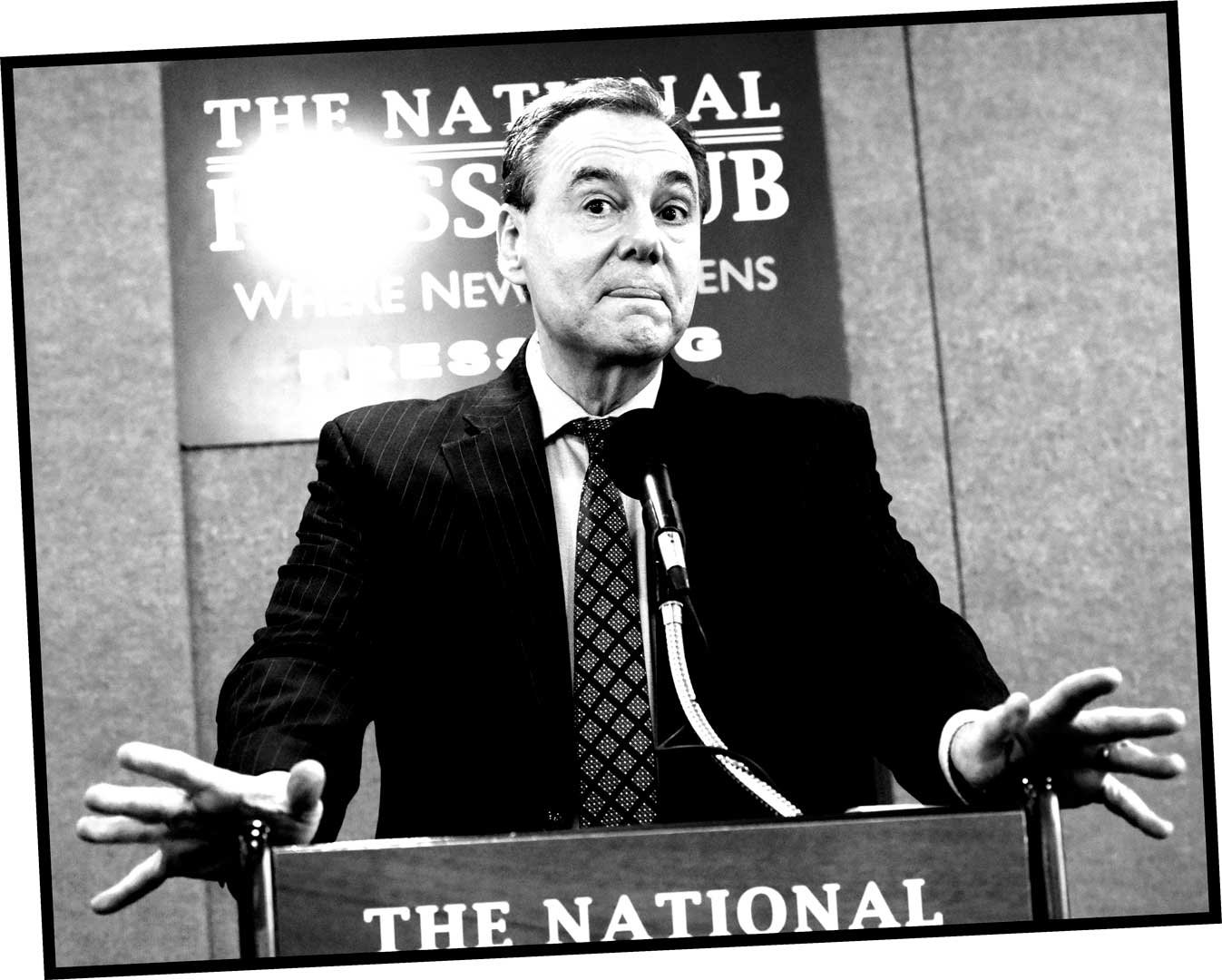
So far, FAIR’s wishes are coming true. Five days after taking office in January, Trump signed an executive order vowing to crack down on undocumented immigrants, retaliate against so-called sanctuary cities, and tighten security along the border with Mexico. An uptick of immigration enforcement activity followed, and ICE agents carried out sweeps in communities across the country. As attorney general, Sessions has threatened to withhold Justice Department funding from cities that refuse to comply with federal immigration laws, playing up the unsubstantiated claim that undocumented immigrants pose a major threat to public safety. Trump’s White House recently opened a new office to engage with “victims of immigration crime.”
“It feels nice to see an administration that notices what the average American sees and cares about the immigration issue,” Stein said. “We give them a really high grade; he’s gotten a lot done.”
FAIR didn’t just luck out with a surprise presidential candidate who shared its views and whom few believed would actually win. FAIR and its affiliated groups NumbersUSA and Centers for Immigration Studies — together known as the Tanton network — have been building the modern nativist movement behind the scenes for decades, especially within the Republican Party. Trump’s immigration policies are the direct product of a deliberate and sustained effort the group started in 1979 — and now critics on both left and right say FAIR has successfully hijacked the immigration debate and normalized its radical ideas, even as the American public grows more accepting of immigrants. FAIR now claims a membership and support network of more than 1.3 million people and has an annual budget of more than $5.5 million.
Rick Swartz, a longtime political strategist, founded the pro-immigrant advocacy group the National Immigration Forum in 1982, around the time FAIR got its start, and watched with alarm as the influence of Tanton’s organizations grew. “The FAIR network and its close ties to Trump reflect a 35-year strategy of blatant demagoguery and sophisticated innuendo,” he said, “which has provided the kindling for this era’s example of anti-immigrant backlash.”
Simmering nativism
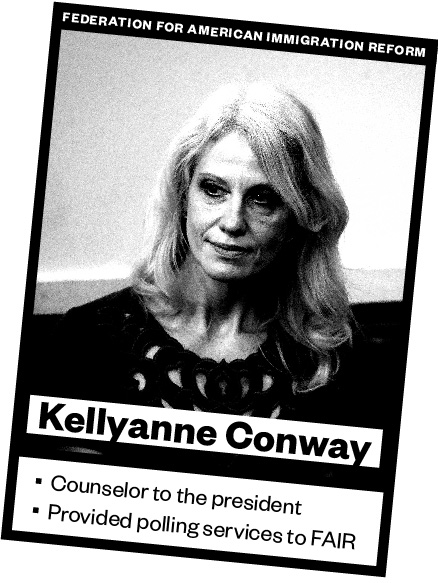
In a 2014 post on its website, FAIR cited a survey by Kellyanne Conway’s firm, its longtime pollster, that claimed the majority of Americans wanted more of the kind of aggressive immigration enforcement the Trump administration is now pursuing. “I have never seen immigration at the level where it is in terms of American consciousness,” Conway, who went on to serve as a campaign manager for Trump and is now a counselor to the president, said at a panel discussing the poll results. “‘Out of sight, out of mind’ is over. People know what they see, and seeing, of course for the public, is the first step toward believing.”
Other research shows the truth is a little more complex. The nonpartisan Pew Research Center has repeatedly found that FAIR’s hard-line, zero-tolerance position on undocumented immigration does not align with the views of most Americans. More than 20 years ago, nearly two-thirds of Americans believed immigrants were a burden because they were stealing people’s jobs and healthcare, compared to 27 percent in 2016. Now, most people favor both improved border security and making it easier for unauthorized immigrants residing in the U.S. to obtain citizenship.
But Pew has also identified a growing partisan divide. In 1994, only about 30 percent of both Republicans and Democrats said they thought immigrants strengthened the United States through their hard work and talents. Now, views of immigrants and immigration tend to fall along party lines. Today, 82 percent of Democrats hold that view, compared to 39 percent of Republicans. FAIR and hard-liners like Sessions have long pushed the idea that immigrants make crime worse — 71 percent of Republicans share this view, compared to 34 percent of Democrats.
FAIR exploited this divide throughout the late ’90s and into the 2000s, as the group’s leaders set their sights on bringing about a culture shift in the way Americans thought about immigration. “Twenty years ago, FAIR was a weird fringe organization,” said Alex Nowrasteh, an immigration policy analyst for the CATO Institute, a libertarian think tank. “Since then, they’ve gotten their hooks and talons into the Republicans, and wormed their way into the conservative movement. And they’ve been very successful.”
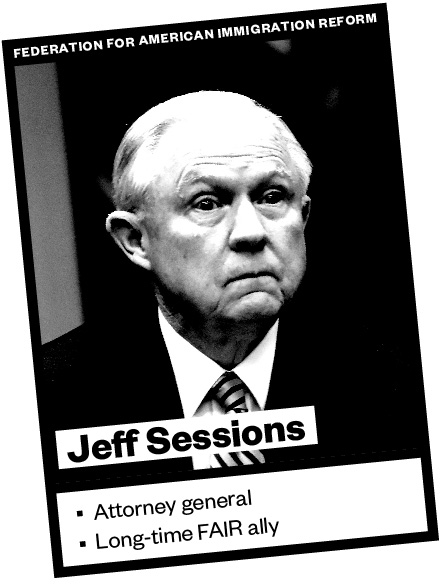
Until Trump’s election, immigration hard-liners’ most significant victories were tanking the two best chances at comprehensive immigration overhaul in recent memory: a bipartisan effort begun under President George W. Bush in 2007 and a second effort launched under President Obama in 2013. FAIR and its allies were instrumental in defeating both. “It was on the one hand talk radio,” said Carlos Gutierrez, Bush’s secretary of commerce at the time. “On the other, it was these groups: FAIR and NumbersUSA, Center for Immigration Studies.” (Other analyses suggested labor unions also helped torpedo the bill.)
Sessions, who was on the Senate Judiciary Committee, fought so hard against the 2007 bill that FAIR gave him a prize. “Like a grandmaster chess player, Sessions devised strategy after strategy to block, thwart, delay, and ultimately defeat the bill,” FAIR crowed in its November 2007 newsletter.
FAIR’s growing influence troubled the Southern Poverty Law Center, which first gave it the “hate group” label that year. SPLC was concerned about the vicious turn that the immigration debate had taken. “What we are hoping very much to accomplish is to marginalize FAIR,” Mark Potok, a senior fellow at the center, said at the time.
During the Obama years, immigration grew even more contentious and rhetoric intensified on both sides. Reform advocates and Latino leaders said Obama failed to fulfill his campaign promises of overhauling the immigration system. He was nicknamed “deporter-in-chief” and forcibly removed more than 2.8 million undocumented immigrants over the eight years of his administration — more than any other president.
Roberto Lovato, a co-founder of Presente.org, a Latinx social justice network, said that Obama was “the most destructive force in migration to date” and an example of how the Democrats became increasingly willing to “play hard on immigrants to get votes.”
His deportation efforts weren’t enough for immigration hard-liners, though, and they accused the Obama administration of trying to undermine the law through its efforts to extend protections to undocumented immigrants who arrived in the U.S. as children, known as Dreamers.
In 2010, Kris Kobach, legal counsel to the Immigration Reform Law Institute, FAIR’s litigation arm, helped draft Arizona SB 1070. The broad and restrictive measure was designed to crack down on undocumented residents and sanctioned the racial profiling of Latinos (that provision of the bill was struck down by the Supreme Court in 2012). Governors and legislators in other states pushed similar legislation; a Mother Jones analysis found that state legislatures across the country passed 164 anti-immigration bills between 2010 and 2011, many of which were closely modeled after SB 1070.
“All this represents a high-water mark in the influence of the ‘nativist lobby,’’’ conservative political commentator Morton Kondracke wrote in a 2011 article for Roll Call. He added that FAIR and similar groups were “making use of economic hard times to argue that immigrants — legal and illegal — are stealing jobs from Americans and straining government budgets.”
During his renewed efforts to defeat immigration reform in 2013, Sessions argued that American workers were getting screwed even as the economy recovered from the Great Recession. He railed against the “Gang of Eight” Senate bill, a mammoth 855-page piece of legislation that proposed an overhaul of the immigration system, including the creation of a new visa program for low-skilled guest workers, and a higher annual cap for H1-B visas for high-skilled immigrants. It passed the Senate 68-32 but encountered bitter opposition from conservatives and ultimately died in the House.
When Sessions became attorney general earlier this year, FAIR called the choice “unparalleled.” In a press release, the group said Sessions would restore the rule of immigration law and end any chance at so-called amnesty for undocumented immigrants. “Jeff Sessions is the man!” Stein told me. “He’s great. I wish we had 20 of him. He’s a national hero.”
Environmentalism and eugenics
FAIR was founded in 1979 by John Tanton, an opthamologist and avid beekeeper from Petoskey, Michigan, a small, mostly white town on the shores of Lake Michigan. Tanton was a radical environmentalist, though he worked with mainstream environmental groups like the Sierra Club. His environmentalism coincided with a keen interest in population control; he founded local chapters of Planned Parenthood and served as the president of Zero Population Growth, a group that pushes to make contraceptives and abortion services more accessible.
Yet Tanton was unable to persuade his colleagues of what he saw as a more pressing population and environmental issue: the threat of immigration. The U.S. immigrant population had swelled by 5 million people in just one decade, the sharpest increase in more than 100 years. These new arrivals looked different from immigrants in earlier decades; they were less likely to come from Europe and more likely to come from Latin America and Asia. Tanton was urgently concerned about resulting urban sprawl and the degradation of the natural environment it could bring. He believed the United States had hit a breaking point and was no longer able to support newcomers.
Like Tanton, FAIR’s early board members subscribed to a brand of environmentalism that emphasized eugenics. One was an ecologist who advocated forced sterilization; another had argued that U.S. diversity efforts were “Europhobic.” FAIR received early financial support from the Pioneer Fund, a group promoting eugenics.
At its founding, FAIR wanted to drastically cut immigration and was extremely critical of the Immigration and Nationality Act of 1965, which abolished a “national origins” quota system for immigrants. The group conducted research and analysis to support its work. “We haven’t changed that much except now we have new tools to reach out to a broader audience,” Stein said.
In the 20 years that followed, Tanton founded or funded at least a dozen more national and regional groups, including the Center for Immigration Studies, a spin-off research organization created in 1985. FAIR, CIS, and three other Tanton-affiliated organizations have been labeled hate groups by the Southern Poverty Law Center.
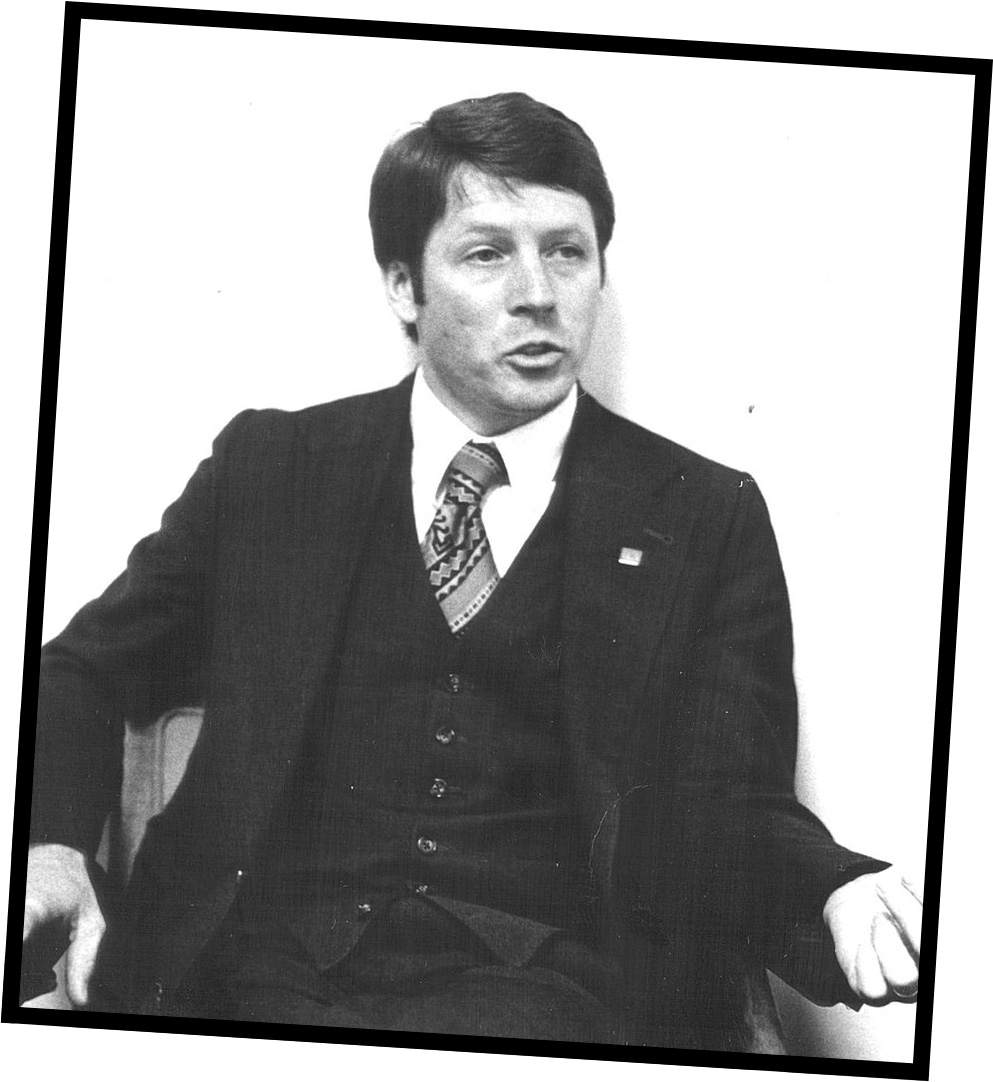
In its first decade, FAIR flew more or less under the radar, and the Tanton network of organizations attracted a diverse range of supporters from both sides of the aisle. Legendary broadcaster Walter Cronkite joined the board of U.S. English, a Tanton brainchild established in 1983 whose goal was to make English the country’s official language. Linda Chavez — who would go on to be nominated as secretary of labor by President George W. Bush — was hired as president of U.S. English. Chavez said in a recent interview that she had personal reservations about Tanton and the messaging coming out of some of his other groups. But she thought U.S. English’s pursuit was noble: It would encourage new arrivals to speak the language, making it easier for them to find gainful employment.
But then, in 1988, the Arizona Republic got hold of a series of memos that laid bare some of the ideological underpinnings of Tanton’s groups and revealed his deeper concerns about whether new arrivals — which he deemed a “Latin onslaught” — were assimilating.
When the memos came out, a reporter from the Arizona Republic called Chavez and read their contents aloud over the phone: “Is apartheid in Southern California inevitable?” “Will Latin American migrants bring with them the tradition of the mordida (bribe)?”
“I found them appalling, I found them racist,” Chavez recalled. “I got off the phone and I immediately called to tell Tanton and the board that I was resigning.” Cronkite also resigned.
FAIR gained some notoriety from the memos, and Tanton and the group were branded nativist weirdos, said Nowrasteh, the CATO Institute analyst. “They hate Mexicans. They have this environmental obsession, this throwback environmentalism, combined with pro-choice philosophies. They were this weird movement on the fringes of American conservatism,” he said.
But rather than do damage control, Tanton doubled down, confident enough that his ideas would eventually land. Between 1991 and 2015, he wrote and self-published almost 70 lengthy editorials on the Social Contract, his blog. In those writings, he likens international borders to membranes keeping the body safe from diseases.
One 1993 essay titled “Alien Invasion!” described a jellyfish-like creature “that reproduces rapidly and eats everything in sight,” killing native species “directly and by depriving them of food.” In a 1994 essay, he mused over “an intense movement that is hostile to the European descendants of those who settled and founded this country and to their culture.”
Even then, Tanton was careful to speak in dog whistles, often stopping himself just short of naked racism. Today, FAIR treads even more carefully, using phrases like “common sense immigration reform.” That “common sense” includes ending birthright citizenship for people whose parents weren’t born here and branding anyone who comes over the border without authorization a criminal.
“At the end of the day,” said the Southern Poverty Law Center’s Potok, “FAIR talks nice, but they’re a racist organization.”
Stein strongly rejects the SPLC’s “hate group” label, calling it an “outrageous lie” and the product of a “smear campaign” waged in the 2000s by Democrats who, he says, prioritized immigrants and corporate lobbyists and grew increasingly out of touch with working-class voters. FAIR recently escalated its war with SPLC; earlier this month, it filed a lawsuit accusing the Alabama-based organization of engaging in improper political activity in violation of its tax-exempt status.
Stein seemed keen to disassociate FAIR from Tanton, who is now in his mid-80s, and told me he has little to do with daily operations. “As a creative intellectual he pursued many different issues on a range of topics. Because he was not a political person and did not see himself as being a public figure in that way, creative intellects sometimes don’t say things artfully,” Stein said.
Tanton is suffering from Parkinson’s disease and was unable to comment. He is still listed as a national adviser on the group’s website.
From fringe to center
Tanton and FAIR’s president in the 1980s, Roger Conner, had a long-term strategy to grow their influence, but some real-life events helped FAIR out of the fringes and into notoriety and then into quasi-respectability and then to now, when their long-held views on immigration match those coming out of the White House. Two events, in particular — 9/11 and the Great Recession — fostered a climate where immigrants became easy scapegoats for complex problems.
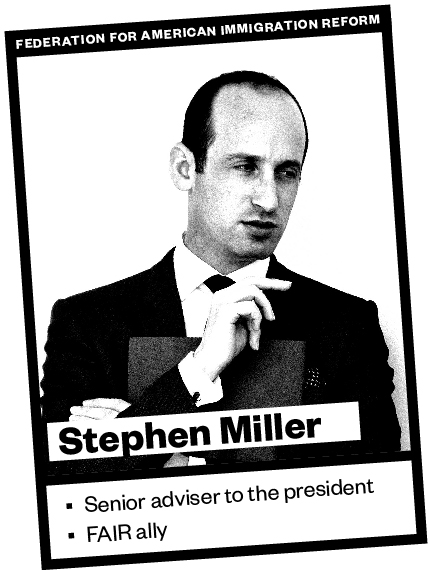
From the get-go, FAIR pursued a “low-key, behind-the-scenes approach,” according to internal memos, and shifted energy from lobbying and media relations to grassroots organizing. They also began a targeted infiltration of key posts in Congress, particularly the Judiciary subcommittees on immigration in the House and Senate, where they hoped to install sympathetic staffers.
FAIR’s legal director, Cordia Strom, was chief counsel to Rep. Lamar Smith, a Texas Republican who chaired the House immigration subcommittee and introduced the 1996 Illegal Immigration Reform and Immigrant Responsibility Act. The measure tightened American borders and cracked down on undocumented immigrants and legal permanent residents who had children or families residing in the U.S. FAIR’s fingerprints were all over it.
As FAIR maneuvered on the Hill, it also drummed up grassroots support in some predominantly white parts of the country, like Iowa, where immigration was intensifying as an issue. One FAIR campaign in Storm Lake, Iowa, portrayed the town as overrun by an “influx of Hispanic meatpacking workers,” the Des Moines Register reported. The governor dismissed the spot as “propaganda,” but a poll showed residents agreed with the message.
Then 9/11 happened, transforming the immigration debate overnight. In its 2001 annual report, FAIR boasted that, immediately following the attacks, it “swung into action to ensure that the public understood the role that lax immigration played in the tragedy.”
In the aftermath, Stein was booked for newspaper and TV interviews, and journalists and broadcasters seeking to flesh out both sides of the immigration debate increasingly saw FAIR as a credible voice on the right. According to its own figures, in 2002, FAIR representatives were quoted in 5,000 media outlets and made 200 TV appearances, doubling their numbers from the year before.
In 2003, longtime CNN reporter Lou Dobbs — a self-described “independent populist” — got his own nightly broadcast. Dobbs regularly offered a mainstream platform to immigration hard-liners, and he often invited Stein — who by then had been promoted to FAIR president — to participate in discussions about immigration on his show. A later study by Media Matters, a left-wing journalism watchdog, found that Dobbs dedicated 77 out of 140 discussion hours from January to July in 2009 to the issues of immigration and “illegal aliens.”
Dobbs regularly attended FAIR’s annual “Hold Their Feet to the Fire” event — a lobbying and talk-radio extravaganza — and in 2008, he broadcast from the event’s rally, where he said on live television that FAIR was “to be commended.” Around the same time, he started giving credence to the false “birther” conspiracy about President Obama put forward by Donald Trump.
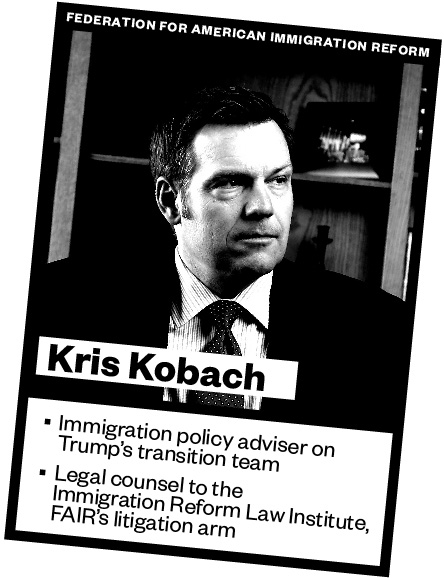
But FAIR wasn’t just enjoying more airtime to promote its views to the public; the organization and its allies were gaining traction with local lawmakers. Frustrated by what they saw as the federal government’s repeated failure to secure the border, some local jurisdictions in the U.S. took matters into their own hands, with the help of Kobach. Small cities in Pennsylvania (including Hazelton, where Lou Barletta, later a member of Trump’s transition team, was then serving as mayor), Missouri, California, and Nebraska passed a flurry of laws between 2006 and 2007 aiming to make life difficult for undocumented immigrants. Kobach reportedly saw these places as testing grounds for the hard-line policies he would later pursue in Arizona.
On the federal level, FAIR doggedly continued to court lawmakers and congressional staffers. From 2000 to 2009, FAIR’s spending on “government relations” more than doubled, to nearly $675,000, tax returns show. In 2015, FAIR spent nearly $1 million on this category, far outpacing increased expenditures in areas such as public education (where spending declined).
Brian Bilbray, a former Republican congressman from California, worked as a lobbyist for FAIR between 2002 and 2005, earning almost $300,000, and co-chaired the organization’s National Board of Advisers. In 2006, he was re-elected to Congress and became chair of the House Immigration Reform Caucus, a majority-Republican group that promoted restrictive immigration policies. Bilbray remains on FAIR’s board.
FAIR’s renewed schmoozing on the Hill paid off, particularly in the post-9/11 climate. Representatives from FAIR were invited to testify on immigration issues at least 30 times before Congress between 2001 and 2007, according to an estimate from the Southern Poverty Law Center. And FAIR’s influence was especially important as Congress began to weigh the comprehensive immigration reform bill in 2007.
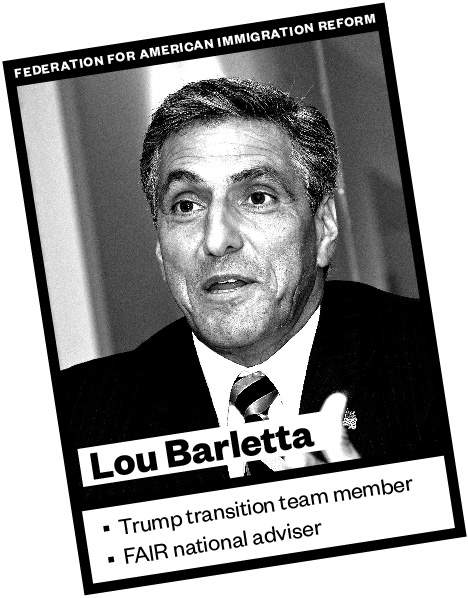
In 2009, 18 members of the House Immigration Reform Caucus attended FAIR’s “Hold Their Feet to the Fire” event, as did five senators, including Sessions. Dobbs headlined the event, and Wisconsin Congressman Paul Ryan, then the ranking Republican member of the House Budget Committee, also attended.
Pro-immigrant groups pounced on Ryan’s and Dobbs’ involvement in the event as an example of how FAIR’s rhetoric was becoming normalized in politics and the media. A Milwaukee-based immigrant rights group organized local high school students to march outside Ryan’s office in Racine, prompting him to quickly release a statement saying he neither endorsed nor supported FAIR; he said he only joined a radio broadcast of the event to discuss “healthcare reform and the Green Bay Packers.”
Dobbs also came under fire. Lovato, the Presente.org founder, spearheaded a campaign called “Basta Dobbs,” pressuring CNN to remove him from the air on account of his anti-immigrant views and affiliations with groups like FAIR. Dobbs resigned two months later but did not say whether his sudden departure had anything to do with his relationship to the organization.
But even amid the public outcry over FAIR, Dan Stein was invited to the Capitol just a few months later to give a press conference alongside members of Congress about the dangers of unauthorized immigration and how “illegal aliens” could exploit loopholes in pending Obamacare legislation. At that point, the Immigration Reform Caucus counted 94 members, or about a quarter of the U.S. House of Representatives.
Vindication
Once upon a time, it would have been political suicide for a mainstream politician to use the kind of rhetoric seen in Tanton’s early writings and even contemporary FAIR press releases. And until recently, FAIR’s ideas were far from orthodox for conservatives.
Nowrasteh argues that FAIR policy is at odds with the religious right because it “fundamentally devalues human life, especially life from outside of the United States” and tries to “portray people as a cost rather than a benefit.” It also conflicts with the ideals of neo-conservatives and pro-military interventionists who believe “the power of government is determined by the size of population, and how powerful their ideals are,” he said. And closed borders shouldn’t fit with Republican economic policy, which typically values a free market that thrives on the unfettered flow of workers and businesses.
But Donald Trump was able to exploit these contradictions on the right and capitalize on the pockets of support that FAIR and like-minded groups had built across the country, pouncing on everyday voters’ hardships and fears while quietly courting hard-liners on the Hill. “Donald Trump, whose signature issue was ‘the other,’ has now propelled the Tanton vision to the highest level of the government,” said Swartz, the political strategist.
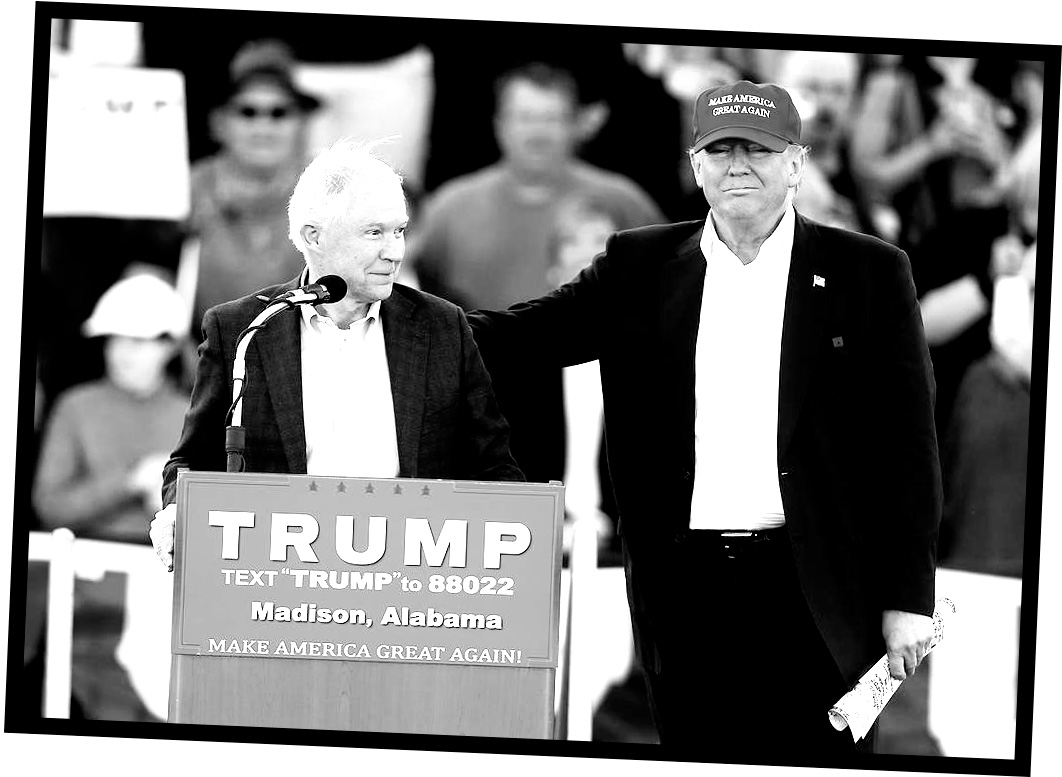
A Harvard study published in August 2016 weighed two driving factors in the seemingly meteoric rise of Trump (and populist movements such as Brexit): growing socioeconomic inequality and a “cultural backlash” alongside “nostalgic reaction among older sectors of the electorate seeking a bulwark” against change in the form of cultural or demographic shifts.
According to exit polling, 64 percent of Trump voters said that immigration was the most pressing issue to them (compared to 33 percent of Hillary Clinton voters). A whopping 83 percent of Trump voters said undocumented immigrants should be deported, while 61 percent of Democrats thought those individuals should be offered a path to citizenship.
Even though Trump’s brash talk on immigrants shocked the political establishment and made international headlines, the substance of his ideas wasn’t new; he just gave the ideas their biggest platform to date.
“He became [FAIR’s] spokesman,” Chavez, the former U.S. English president, said. “He became the face of the anti-immigrant movement from the moment he rode the gold escalator down and started talking about Mexicans as criminals and drug dealers.”
In its nearly three decades, FAIR has not once officially endorsed a political candidate, and Trump was no exception. But for Stein, Trump’s presidency is a vindication. “If our ideas are finding hospitable reception in the White House, it means we were right!” he said. “We were right all along!”
Yet whenever I spoke to Stein, he stopped short of claiming Trump’s victory as a victory for FAIR, even though the group now has friends in high places who are helping the new president craft his administration’s immigration policy.
“The administration is the administration that operates as the administration,” Stein said. “If you’re trying to suggest we’re some cat’s paw controlling the administration — it’s a nice try, but the simple reality is that FAIR has been around for 35 years. That doesn’t make us the center of some conspiracy.”
Stein, a native Washingtonian, said he’s lived in D.C. long enough to know that simply laying claim to influence doesn’t get you anywhere. “Influence is achieved by good ideas, timely, delivered to the right folks,” he said. “Nobody is interested in people in Washington sitting around and claiming they are running the world.”
Morgan Conley contributed research.
Tess Owen is a reporter covering civil rights for VICE News.
